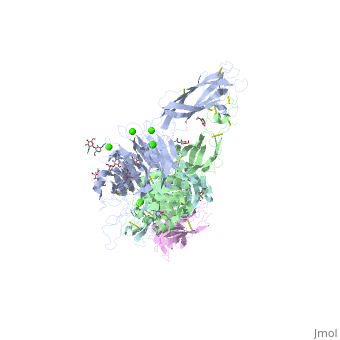Molecular Playground/IntegrinBeta1
From Proteopedia
| Line 8: | Line 8: | ||
| - | Here are the <scene name='60/609772/N-acetyl-d-glucosamine/2'>N-acetyl-d-glucosamine locations!</scene> | ||
==Function== | ==Function== | ||
| - | Integrins are a class of surface proteins that bind to extracellular matrix components and transmit chemical and mechanical cues to internal signaling pathways. Integrin beta 1 binds many proteins when dimerized with an alpha subunit, including collagen, laminin and fibronectin. | + | Integrins are a class of surface proteins that bind to extracellular matrix components and transmit chemical and mechanical cues to internal signaling pathways. Integrin beta 1 binds many proteins when dimerized with an alpha subunit, including collagen, laminin and fibronectin. Integrin adhesion to the extra cellular matrix is key for cell ability to adhere, migrate and proliferate in both 2D and 3D systems. These will eventually form adhesion complexes, which regulate actomyocin polymerization. During migration, cells continually form new focal adhesions at the leading edge of the cell and release adhesion complexes at the back of the cell, enabling forward movement. |
| + | |||
| + | Here are the <scene name='60/609772/N-acetyl-d-glucosamine/2'>N-acetyl-d-glucosamine locations!</scene> N-acetyl-D-glucosamine may regulate integrin signaling during cancer cell migration.[1] | ||
==Integrins and cancer== | ==Integrins and cancer== | ||
| Line 21: | Line 22: | ||
==References== | ==References== | ||
| + | [1] C. Saravanan, F. Liu, I.K. Gipson and N. Panjwani1. Galectin-3 promotes lamellipodia formation in epithelial cells by interacting with complex N-glycans on 31 integrin. Journal of Cell Science 122, 3684-3693 Published by The Company of Biologists (2009). doi:10.1242/jcs.045674. | ||
Revision as of 18:44, 19 November 2014
One of the CBI Molecules being studied in the University of Massachusetts Amherst Chemistry-Biology Interface Program at UMass Amherst and on display at the Molecular Playground. Molecular Playground banner: "
Banner: Integrin Beta 1 binds to ECM proteins and allows for 3D in vitro cell migration
|
Contents |
Structure
Function
Integrins are a class of surface proteins that bind to extracellular matrix components and transmit chemical and mechanical cues to internal signaling pathways. Integrin beta 1 binds many proteins when dimerized with an alpha subunit, including collagen, laminin and fibronectin. Integrin adhesion to the extra cellular matrix is key for cell ability to adhere, migrate and proliferate in both 2D and 3D systems. These will eventually form adhesion complexes, which regulate actomyocin polymerization. During migration, cells continually form new focal adhesions at the leading edge of the cell and release adhesion complexes at the back of the cell, enabling forward movement.
Here are the N-acetyl-D-glucosamine may regulate integrin signaling during cancer cell migration.[1]
Integrins and cancer
Studying Integrin Beta-1 in vitro
Peyton Lab Research Interests
The Peyton lab studies how cells process chemical and physical cues from the extracellular matrix and how these interactions play a role in the progression of cardiovascular disease and cancer. We aim to understand the downstream signaling pathways activated when cells use their integrins to bind to matrix and how this translates to the disease of interest.
References
[1] C. Saravanan, F. Liu, I.K. Gipson and N. Panjwani1. Galectin-3 promotes lamellipodia formation in epithelial cells by interacting with complex N-glycans on 31 integrin. Journal of Cell Science 122, 3684-3693 Published by The Company of Biologists (2009). doi:10.1242/jcs.045674.
Proteopedia Page Contributors and Editors (what is this?)
Lauren Barney, Lauren Jansen, Elizabeth Brooks, Michal Harel, Alyssa Schwartz

